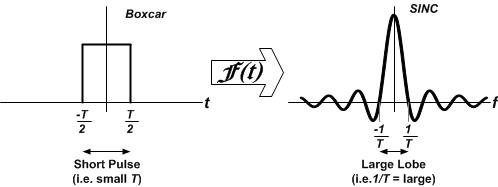SSZTCQ2 may 2015 ADC12J4000
** This is the second post in a new RF-sampling blog series that’ll appear monthly on Analog Wire **
“If something isn’t broken, don’t fix it” is an old saying many people live by. So why should you bother with the new radio frequency (RF) sampling data converters? In one word, the answer is bandwidth. While the current devices aren’t exactly broken, they are not sufficient to support the increasing demand for bandwidth. The new RF sampling devices significantly increase the sampling rate to support higher-bandwidth signals.
So why is higher bandwidth so important? Let’s look at two key considerations: one in the time domain and one in the frequency domain.
Some applications, like radar, optical time-domain reflectometry (OTDR) and electronic warfare, use short-duration pulsed signals. Figure 1 illustrates an ideal boxcar pulse in the time domain. To understand its impact on bandwidth, this function is Fourier-transformed into the frequency domain. An ideal boxcar pulse transforms to a sinc function (sin[x]/x) in the frequency domain. The pulse width in the time domain is inversely proportional to the main-lobe bandwidth in the frequency domain. As the pulse width becomes smaller, the main lobe in the sinc function becomes larger. In other words, a shorter time pulse requires higher bandwidth capabilities. Taken to the ideal extreme, an instantaneous pulse (an impulse function) with no time duration transforms into infinite bandwidth.
 Figure 1 Pulse Signal
Fourier-transformed into the Frequency Domain
Figure 1 Pulse Signal
Fourier-transformed into the Frequency DomainHigh-data-rate communication systems typically use wide bandwidth signals to pass large amounts of data and provide channel-impairment immunity to effects like fading or jamming. Previously, the sampling rate of the data converter limited the maximum bandwidth of the signal that the system could support. The sampling theorem dictates that the sampling rate of the data converter must be at least twice the highest bandwidth of the signal; hence, higher sampling rates equate to larger bandwidth capability.
Figure 2 illustrates two cases with equivalent system-bandwidth capabilities. The first case has a large continuous-bandwidth signal that occupies the full extent of the data converter’s system bandwidth. The second case illustrates two smaller-bandwidth signals separated into frequencies in which their outside edges fall within the data converter’s system bandwidth. It is possible to place as many different signals of any desired bandwidth within the allotted space as you like. Previously, you would have had to separate each signal on its own transceiver. Now, RF sampling data converters allow all of the signals to reside within one transceiver.
 Figure 2 RF Sampling Data Converter’s
System Bandwidth
Figure 2 RF Sampling Data Converter’s
System BandwidthThe ADC12J4000 analog-to-digital converter (ADC) operates at a sampling rate of 4GSPS. This particular RF sampling device can support up to 2GHz of bandwidth which opens up new opportunities with higher-resolution pulses and higher data rates for next-generation systems.
So don’t ask “Why RF sampling?” That answer is clear. Instead, ask “What bandwidth is needed?” to determine the appropriate sampling-rate requirements of your data converter.
Come back next month, when I’ll discuss managing the input data rates of RF sampling data converters.